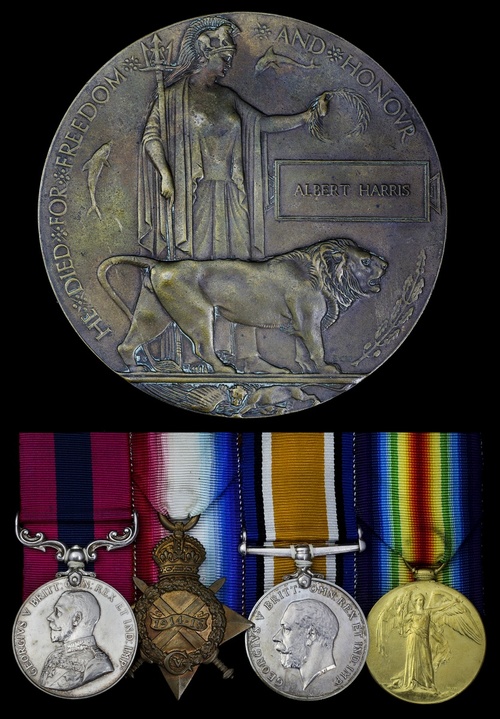
Auction: 19001 - Orders, Decorations and Medals
Lot: 486
Welsh Regiment
'We wore 'tin hats' and the intense heat of the sun made out heads feel like poached eggs. The battle of Khuweilfeh has been described in many narratives and despatches, but I have never seen mentioned the appalling shortage of water from which we suffered. We had about three pints for forty-eight hours, which included a long march up the stifling winding ravines of the Judean foothills, followed by incessant fighting, the temperature, thanks to the Khamsin which prevailed, being that of August. It was real hell. A lot of men went nearly mad with thirst.'
Le Fleming's History of the 53rd (Welsh) T.F. Division, refers.
A rare - highly unusual - Great War Third Battle of Gaza posthumous D.C.M. group of four awarded to Private A. J. Harris, 1/5th Battalion, Welsh Regiment
As verified in his unit's war diary, his D.C.M. was for gallantry in storming Turkish positions on Ain Kohle - to the south-west of the infamous Khuweilfeh Heights - on 3 November 1917, the same date on which he was killed in action
Distinguished Conduct Medal, G.V.R. (240726 Pte. A. J. Harris, 1/5 Welsh R.-T.F.); 1914-15 Star (2226 Pte. A. J. Harris, Welsh R.); British War and Victory Medals (2226 Pte. A. J. Harris, Welsh R.), together with Memorial Plaque 1914-18 (Albert Harris), extremely fine (5)
D.C.M. London Gazette 18 February 1918:
'For conspicuous gallantry and devotion to duty. He silenced an enemy gun with his Lewis gun. During the attack he collected a few men, entered the enemy position and disarmed and captured a number of the enemy. He showed the greatest courage and initiative.'
Albert John Harris was born in Bath, Wiltshire and enlisted in the Welsh Regiment at Pontypridd. Drafted to the 1/5th Battalion, he first saw action in Gallipoli, which theatre of operations he entered on 22 August 1915. By the time of the unit's evacuation in December, just one officer remained of its original strength.
The Battalion - again as part of 159th Infantry Brigade, a component of 53rd (Welsh) Division - subsequently fought in the Sinai operations and in Palestine and played a notable role in the First Battle of Gaza in March 1917, when it attacked defences around Clay Hill.
At the Third Battle of Gaza, the Division was deployed deep into the desert to the north-east of Beersheba, around the collective area known as the Khuweilfeh Heights. The Battalion objectives for the 3-6 November were intended to be mainly support, with little significant opposition expected. However, an attack against Stone Heap Hill and Horseshoe Hill by 4/Welsh was brought to a halt with heavy casualties, the troops then being spread across a wide front. It was this situation which forced the 5/Welsh to be ordered to attack the strong position of Ain Kohle, gallantly advancing in short rushes along with willing men of their sister battalion:
'The Welshmen were therefore pinned down in the stifling heat at the bottom of the ravines, but in spite of this some ground was gained; at some points as close as 100 to 300 yards from the enemy's position' (Gaza 1917, by Martin Glen, refers).
During this action on 3 November, 20-year-old Harris must have acted on his own initiative to perform the gallant action which cost him his life. He was among 47 men to be killed with another five officers and 146 men wounded.
The son of Mr. and Mrs. A. E. Harris, of 15 Fieldings Road, Twerton-on-Avon, Bath. He is buried in Beersheba Cemetery.
Subject to 20% VAT on Buyer’s Premium. For more information please view Terms and Conditions for Buyers.
Sold for
£1,600




